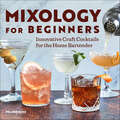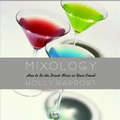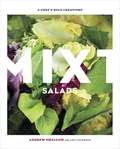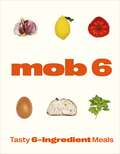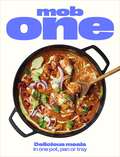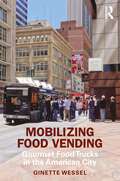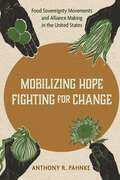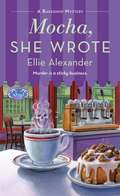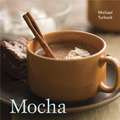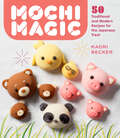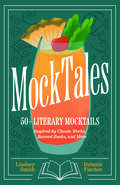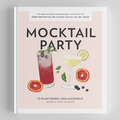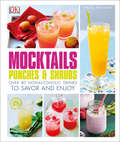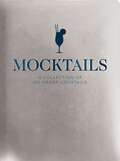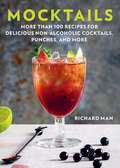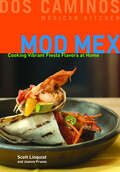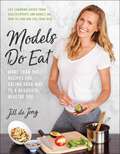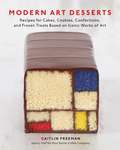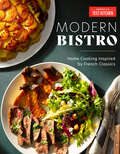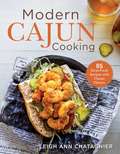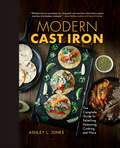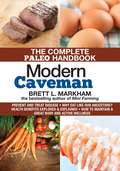- Table View
- List View
Mixology for Beginners: Innovative Craft Cocktails for the Home Bartender
by Prairie RoseShake, stir, and strain perfect cocktails at home The same drinks you enjoy at the bar taste a lot better when they're made skillfully at home for a fraction of the price. Become your own bartender and hone your craft in no time with the expert recipes and guidance inside Mixology for Beginners. You'll also discover a user-friendly layout that indexes recipes by liquor type and flavor profile, so you never have to look hard to find the right cocktail for the occasion.Go beyond other beginner cocktail books with insights on:Building your home bar—Get insider info and shopping advice for fully stocking your bar, including mixologist terminology, glassware, tools, and—of course—liquor.Expert drink making—Learn the fundamentals of crafting signature cocktails, including formulas, naming conventions, and tips on presentation.Accessible recipes—Create a solid beverage repertoire with straightforward, easy-to-source recipes for classic cocktails and new favorites.Gain the skills to craft cocktails at home with this mixology book that makes it simple.
Mixology: How to Be the Drink Mixer in your Crowd
by Holly RapportThis hip, trendy drink-mix guide will appeal to both beginner and advanced cocktail-party hosts. There really is an art to preparing excellent mixed drinks, and MIXOLOGY is a one-stop shop for everything one needs to know about this popular craft. With a straightforward, easy-to-understand and humorous writing style, Holly Rapport guides readers through the 'mixology' process. What does it take to be a master mixologist? For starters, the right bar tools (or the right substitutions), the freshest ingredients, a well-stocked bar, and the desire to serve the best and most delicious drinks possible. Rapport provides helpful tips on how to chill serving glasses, prepare garnishes and sugar/salt rims, and how to serve ice, as well as what glasses to select and how to measure ingredients. MIXOLOGY is a comprehensive guide that will make any party a hit. It features dozens of fantastic new drinks and even includes a section on throwing memorable theme parties. Divided according to alcoholic ingredients, MIXOLOGY lets readers get the most out of any liquor-from vodka to bourbon to brandy to even wine and champagne cocktails. No well-stocked bar should be without it.
Mixt Salads: A Chef's Bold Creations
by Ann Volkwein Andrew SwallowDare to get more out of your greens! From healthy, superfood packed entrée salads to indulgent affairs featuring premium ingredients, this bold collection of more than 60 recipes for voracious omnivores and vivacious salad lovers features unusual and dynamic ingredient pairings that take salads to a whole new level. In Mixt Salads, the co-founder and executive chef of San Francisco's beloved boutique salad joints shares his inventive, flavor-forward creations. Blending all of the best trends in healthy, mindful eating--seasonal, locally grown, modest portions but big flavor--Swallow develops each entrée salad as if he were in the kitchen of a fine dining restaurant. With his penchant for innovative constructions and unabashed flavor, he reinvents the salad with playful yet elegant offerings such as: Porky mixed greens with pork tenderloin, roasted butternut squash, and port reductionDonald duck confit with persimmons and blue cheesesBurger ground Kobe with grilled onionLobster Boat poached lobster with golden beets Swallow teaches you how to create fresh, delicious, and addictive salads that take center stage as the entire meal, breaking free of side-dish status. Starting from scratch, he walks you through his salad-building essentials and highlights produce availability so that you can create your own imaginative masterpieces year round.
Mob 6: Tasty 6-Ingredient Meals
by MobTHE INSTANT SUNDAY TIMES BESTSELLERSix everyday ingredients, incredible quick and easy meals.Mob are back with their much-anticipated simplest cookbook yet: ultra-tasty recipes made with six affordable ingredients, without ever compromising on flavour or originality.Find food for every craving with 115 new recipes, including:Chorizo Mac 'n' Manchego,Crispy Chilli Cauliflower,All-the-Onions SmashburgerHarissa Sausage Orzotto.Finishing off with Sweet Things, such as Negroni Jelly, Tangerine Tiramisu and White Chocolate Tahini Cheesecake.There's a finished photo for every single recipe plus ingredient pictures so you can instantly see what you need.These are unfussy recipes using minimal ingredients delivering all the excitement that defines Mob's modern food.
Mob One: Delicious meals in one pot, pan or tray
by MobOne pan? No problem.Save money and time with this game-changer of a cookbook! Rammed with one-pan, one-pot and one-bowl recipes, these dishes are easy, affordable and – above all else – undeniably delicious to eat.We’ve created over a hundred recipes for you to check out, enjoy and make for your loved ones, including an easy-as-it-gets Vodka Orzotto, a triple ‘ch’ traybake with chicken, chickpeas and chorizo, a veggie spaghetti that manages to taste exactly like buffalo wings and Coffee-roasted Pork Belly to whip out on special occasions.Includes chapters on Easy Ones, Speedy Ones, Fancy Ones and Slow Ones, so you can quickly find exactly the recipe you need, any night of the week.
Mobilizing Food Vending: Gourmet Food Trucks in the American City
by Ginette WesselMobilizing Food Vending investigates the gourmet food truck movement in the United States and provides a clearer understanding of the social and economic factors that shape vendor autonomy and industry growth. The book features case studies in a variety of American cities and uses top-down and bottom-up urban theory to frame a discussion of food trucks’ rights, displacement, and resiliency. Using ethnographic and archival research collected from industry experts, the book examines vendors’ operational strategies, their regulatory challenges when navigating the city, and their economic, cultural, and political roles in shaping urban space. Mobilizing Food Vending argues that food truck vendors are critical actors that support local economies and contribute to the public realm while shaping regulatory policy from the bottom up. This book will appeal to urban scholars studying the contemporary neoliberal city, the public realm, and communication technology and mobility, as well as to urban planners seeking to understand how vendors shape city plans and policies.
Mobilizing Hope, Fighting for Change: Food Sovereignty Movements and Alliance Making in the United States
by Anthony R. PahnkeMobilizing Hope, Fighting for Change analyzes an unusual development in social movement studies and food politics more generally: the formation of an interracial alliance of farmers and farm workers who together demand transformative changes to U.S. agriculture by calling for food sovereignty. Such an alliance, as Anthony R. Pahnke shows, is unusual given how social movement alliances in the United States, particularly those related to agrarian issues, have historically been deeply divided by race and occupation. Pahnke&’s study offers a novel theory for social movement alliance formation, focusing especially on the dynamics of learning. He documents how since the 1980s there have been unprecedented openings for people to work together due to the rise of transnational activist networks, changes in the international political economy, and evolving forms of state authority. Foregrounding the voices of activists, Mobilizing Hope, Fighting for Change compares the trajectories of four U.S.-based movements over time—the Mvskoke Food Sovereignty Initiative based in Oklahoma, the Family Farm Defenders of Wisconsin, the Farmworker Association of Florida, and the Mississippi Association of Cooperatives—documenting how they have united in demanding food sovereignty while remaining distinct from one another.
Mocha Mix Cookbook
by Jeanne JonesA cookbook that provides tips and cooking techniques for "Mocha Mix Non-Dairy Creamer".
Mocha, She Wrote (A Bakeshop Mystery #13)
by Ellie AlexanderWhen a barista competition comes to town, Torte's favorite pastry chef finds herself sleuthing once again—in the next installment of Ellie Alexander's beloved Bakeshop Mystery Series, Mocha, She Wrote!Summer has ushered in a new season in the charming hamlet of Ashland, Oregon. Torte is bustling with tourists taking in star-drenched shows at the Elizabethan, setting out to hike in the surrounding Siskiyou Mountains, and sampling the bakeshop’s summer lineup of raspberry lemon tarts and mint mojito cold brews. Jules and the team are buzzing with excitement when they learn that Andy, Torte’s head barista, has been selected to compete in the West Coast Barista Cup.The prestigious competition draws coffee aficionados from up and down the coast to Ashland. The winner will not only claim to be best-in-brew, but also be awarded a hefty cash prize. Andy’s nervous about his chances, but Jules is confident that her star barista will shine. However, things take a grim turn when head judge Benson Vargas spits out Andy’s first offering, claiming it to be the worst thing to ever touch his lips—and hours later, is found dead clutching Andy’s creamy latte. Suddenly Torte’s favorite barista becomes the number one suspect. There’s no roast for the weary. Jules will have to sleuth out whodunit to clear Andy’s name and catch a killer before she ends up with one foot in the grounds.
Mocha: [A Recipe Book]
by Leo Gong Michael TurbackCoffee and chocolate combined have a complementary effect, which means drinking a mocha wakes you up and puts you in a good mood.High-quality chocolate, strong coffee, and a big mug--basic tools of the trade for Mocha, the sophisticated follow-up to Michael Turback's best-selling Hot Chocolate. Presented in a compact yet luxurious collection, Mocha offers nearly sixty recipes featuring the companionable ingredients of chocolate and coffee. Ranging from cozy cocoa concoctions to caffeinated couture combinations, recipes include hot drinks (the Triple Chocolate Maple Passion hails from Toronto, where they know how to heat things up); cold, refreshing classics (the Black-and-White Espresso Milkshake is almost a meal); creative cocktails (Chocolate-Espresso Martini, anyone?); and outrageous desserts (the Mocha-Java Cheesecake is the richest and smoothest cheesecake ever). Recipe contributors include notable chocolatiers, popular coffee purveyors, preeminent restaurant chefs, and a competitive cadre of coffeehouse baristas. From the Trade Paperback edition.
Mochi Magic: 50 Traditional and Modern Recipes for the Japanese Treat
by Kaori BeckerMochi — the traditional Japanese treat made of chewy rice dough — is a popular and versatile vehicle for all kinds of sweet and savory fillings, and easily molded into adorable shapes and characters that define Japan&’s culture of cuteness. Food writer Kaori Becker&’s easy-to-follow techniques for creating and cooking with mochi deliver the perfect mix of fun and tradition. Each colorful page brims with recipes for hand-pounded, steamed, and modern microwave mochi; fillings like rosewater, Nutella, black sesame, Oreo Cream Cheese, and Japanese plum wine; mochi-focused goodies like Bacon-Wrapped Mochi, Ozoni Soup, baked goods; and inspiration for shaping irresistibly charming mochi flowers, baby chicks, pandas, and more. Kawaii!!
MockTales: 50+ Literary Mocktails Inspired by Classic Works, Banned Books, and More
by Lindsey Smith Delanie FischerEnjoy co-authors Delanie Fischer and Lindsey Smith&’s delicious mocktail adaptations of your favorite books and authors. Beloved stories with a sober twist. Have you ever wondered what the ladies from your favorite Jane Austen books would drink at a ball? What Jay Gatsby would be serving at his crazy parties? Experience these answers for yourself with Lindsey Smith and Delanie Fischer&’s all-new zero-proof drink cookbook. MockTales captures the intoxicating atmosphere of the bestsellers that we know and love. Featuring over fifty plant-based recipes that are easy to make and full of nutritious flavors, you&’ll enjoy your next reread like never before with these delicious mocktails. A toast to the authors who made history. Each recipe inside MockTales is inspired by the literary characters and settings, but also the minds behind these incredible stories. Explore alcohol-free concoctions based on famous authors such as Alice Walker, Ernest Hemingway, Margaret Atwood, and more. Using ingredients that pay homage to their biographies, writing styles, and famous quotes, each sip will have you and fellow book lovers falling in love with these incredible writers all over again. Enjoy over 50 recipes inspired by banned books and literary classics from all genres, such as: Historical fiction novels like Les Miserables, Little Women, and Huckleberry Finn Romance books such as Jane Eyre and Wuthering Heights Fantasy adventures including The Odyssey, Alice in Wonderland, and The Chronicles of Narnia Science fiction and horror tales such as Frankenstein and The Handmaid&’s Tale So if you liked fun mocktail and cocktail books such as Tequila Mockingbird, The Art of Mixology Mocktails, or Flavor Lab Creations, then we recommend MockTales for you.
Mocktail Party: 75 Plant-based, Non-alcoholic Mocktail Recipes For Every Occasion
by Diana Licalzi Kerry BensonSwap your favorite cocktails with these plant-based mocktail alternatives!Developed by two registered dietitians, the non-alcoholic drink recipes in Mocktail Party feature nutritious, all-natural ingredients with minimal sugar that you can easily find at any grocery store. The book also features valuable information about the benefits of an alcohol-free lifestyle, tips for sustainable mixology, and advice for ordering mocktails at a restaurant or bar. If you&’re tired of hangovers and don&’t want to drink sugar-loaded, processed sodas instead, then these healthy and delicious recipes are for you.Mocktail Party includes recipes for every occasion: • Classics like a Pal-no-ma and Aperol-less Spritz • Drinks with a twist like Watermelon Mock-jito & Summer Jam Fresca • Brunch favorites like No-Bull Bloody & Kiwi No-secco • Dessert treats like Salted Carmel & Tiramisu Mock-tinis • Frozen coolers like No Way Frose & Blueberry Acai Daiquiri • Holiday beverages like Pumpkin Spice Latte & Warm Cider and Sage Join the growing movement of health-conscious people who are cutting down on alcohol and opting to "make it a mocktail" instead.
Mocktails, Punches, and Shrubs: Over 80 Nonalcoholic Drinks to Savor and Enjoy
by Vikas KhannaWhat to drink when you're "not drinking"? Mix up refreshing mocktails with more than 80 unique, delicious non-alcoholic drink options for everyday and any occasion.Michelin-starred celebrity chef Vikas Khanna has created a dazzling collection of non-alcoholic drink recipes, from herbal infusions to new combinations of teas, from tantalizing elixirs, smoothies, and slushies to the trendy shrubs—or drinking vinegars—now taking over the taste buds of foodies worldwide.Mocktails, Punches, and Shrubs includes step-by-step instructions for drinks that showcase innovative blends of not-so-common fruits, vegetables, sauces, and syrups to concoct interesting, healthy drinks. Tips and variations allow you to play with your imagination and create custom concoctions suited to your individual palate.Mocktails, Punches, and Shrubs is a beautiful recipe book for conscientious hosts, those who abstain from alcohol for pregnancy or health and wellness, or who just love a refreshing, unique, delicious beverage sure to lift the spirits.
Mocktails: A Collection of Low-Proof, No-Proof Cocktails
by Cider Mill PressThis collection of 75+ irresistible mocktails are carefully hand crafted to bring amazing flavor to every sip. Everyone has finished a bad cocktail, if only for the alcohol. For a mocktail, there is no such saving grace—it lives and dies on taste alone. That&’s why this stunning book contains over 75 zero-proof recipes that emphasize flavor. These inventive, refreshing drinks are perfect for every guest and occasion. Whether you want to make the kids feel grown up, don&’t drink alcohol, or are just not in the mood for booze, these mocktails offer something for everyone. Not only are they much more interesting to drink than soda, but they also offer the wide range of flavor profiles that makes the world of cocktails so dynamic. Experiment with these mocktails, find your favorites, and make them part of your routine. Inside this beautiful book, you&’ll find:NojitoFuzzless NavelVirgin MaryNon Island Iced TeaThornless RoseVanilla-Peach SpritzerMatcha MockaritaChocolate-Espresso Mocktail Cutting back on alcohol doesn&’t mean you have to give up a good drink. Inventive enough to appease the experienced mocktail creator but approachable enough for complete beginners, Mocktails is your go-to guide for simple and gorgeous no-proof beverages.
Mocktails: More Than 50 Recipes for Delicious Non-Alcoholic Cocktails, Punches, and More
by Richard ManDrinks with All the Tastiness of a Well-Formed Craft Cocktail, but Without the Alcohol! Choosing to be alcohol-free is becoming more and more popular, and the range of non-alcoholic drink options is growing steadily in the stores. But many of us are still in doubt when it comes to combining drinks with food. Water, juice, and possibly non-alcoholic beer are probably the options most of us who prefer not to imbibe finally choose. But when you have dinner, these options may not feel as exciting as a well-chosen wine, and are they really always the perfect choice? Water, juice, tea, kombucha, lemonade, and non-alcoholic beer and wine—everything has a place on the dinner table if you only know what drink you should choose for what kind of food, and in Mocktails, Richard Man will help you choose the right one. In this book, you’ll find inspiration and recipes for making non-alcoholic beverages such as:Blackberry SpritzerRhub and HoneyJuniper Berry & TonicHorchata de AlmendrasRuby Red KombuchaLagermonadeTropical Matcha MojitoRed Tea PunchBackyard HighballAnd many more From simple, five-minute recipes to complicated but elegant cocktails, Mocktails will teach you everything you could want to know about combining delicious food and drink to get the most out of your meal—no alcohol required. As Richard says: “Beverages served with food should match the food, regardless of alcohol content. [It’s] so simple.”
Mod Mex: Cooking Vibrant Fiesta Flavors at Home
by Joanna Pruess Scott LinquistScott Linquist offers a pinata full of flavors. . . . Tacos are jazzed, salsa got snazzed, ceviches have heat, moles ain't sweet, [and the] chili has meat. --New York Magazine * Award-winning chef Scott Linquist transports Mexican flavors (and secrets) from the successful Dos Caminos restaurants to your kitchen table in Mod Mex: Cooking Vibrant Fiesta Flavors at Home. Highlighting regions from the Yucatan to Oaxaca, chef Scott Linquist and cookbook maven Joanna Pruess present more than 125 fresh, inviting, and easy-to-prepare Mexican dishes ranging from Quinoa-Watermelon Salad with Arugula and Baja-Style Mahi-Mahi Tacos to Tuna Ceviche with Mango-Serrano Chile Salsa and Chocolate Layer Cake with Morita Chile-Scented Chocolate Mousse. * In addition to a diverse array of recipes and vibrant four-color photography, informative head notes and sidebars throughout the book offer tips on day-before preparation, recipe variations, cultural insights, cooking techniques, and more. * From the kitchens at Dos Caminos on Park Avenue, SoHo, and Midtown, Linquist satisfies more than 1,000 palates each day. Beyond the three Dos Caminos restaurants in New York City, there are plans for future locations in other major cities.
Modeling Matter: The Chemistry of Food, Investigation Notebook
by The Lawrence Hall of ScienceNIMAC-sourced textbook
Modelling Drying Processes
by Xiao Dong Chen Aditya PutrantoThis comprehensive summary of the state of the art and the ideas behind the reaction engineering approach (REA) to drying processes is an ideal resource for researchers, academics and industry practitioners. Starting with the formulation, modelling and applications of the lumped-REA, it goes on to detail the use of the REA to describe local evaporation and condensation, and its coupling with equations of conservation of heat and mass transfer, called the spatial-REA, to model non-equilibrium multiphase drying. Finally, it summarises other established drying models, discussing their features, limitations and comparisons with the REA. Application examples featured throughout help fine-tune the models and implement them for process design and the evaluation of existing drying processes and product quality during drying. Further uses of the principles of REA are demonstrated, including computational fluid dynamics-based modelling, and further expanded to model other simultaneous heat and mass transfer processes.
Models Do Eat: More Than 100 Recipes for Eating Your Way to a Beautiful, Healthy You
by Nikki Sharp Jill De JongGetting fit and the body you want doesn't mean giving up delicious food. "Fit" and "healthy" have become some of the most popular tags on social media, it's sexy to take excellent care of our bodies and minds That's why Jill de Jong, fitness model and personal trainer who provided the real-life body for video game adventure icon Lara Croft, along with nine of her fellow models have come together to share their food philosophies, expertise, and favorite recipes—their secrets to feeling healthy and looking great. Models Do Eat is more than a simple cookbook—it invites you to think critically about nutrition and make better choices for yourself. If you've tried to drop some pounds by depriving yourself of food, you know how miserable and harmful it can be. This team of inspiring women is dedicated to help you make the healthiest possible choices for your body. These models love to eat and they eat a lot. With approaches from paleo and gluten-free eating to vegetarianism and veganism, and everything in-between, Models Do Eat is proof that there's not just one "correct" way to eat well and feel beautiful. Inside discover more than 100 delicious, healthful recipes that promote energy, glowing skin, shiny hair, and weight loss, including Mediterranean Breakfast Cups, Gluten-Free Endless Energy Matcha Muffins, Wholesome Mushroom Tacos, Coconut Basil Sweet Potato Fries, Bison Stew and Bone Broth, Charred Cauliflower with Peppers & Egg, Raw Vegan Cheesecake Bars, and more. These meals will jumpstart your own unique path to looking and feeling like your best self. In addition to their recipe recommendations, you'll get personal stories and insights from: Taylor Walker Sinning (Under Armour model with a Master's in physical education) Courtney James (certified health coach and the face of Aerie and American Eagle) Lauren Williams (Personal trainer & fitness model for Nike, Athleta, Target, and Women's Health) Colleen Baxter (functional medicine practitioner who's walked for Oscar de la Renta and posed for Vogue) Adela Capova (integrative nutritionist featured in Elle, Harper's Bazaar, and GQ) Liana Werner-Gray (Miss Earth Australia and bestselling author of The Earth Diet and 10-Minute Recipes) Summer Rayne Oakes (certified holistic nutritionist featured in the elite Pirelli Calendar) Nikki Sharp (naturopath, raw foods expert, and frequent face on Access Hollywood and Extra! TV) Sarah DeAnna (bestselling author of Supermodel You) Anyone can eat like a model and reap the benefits, inside and out. Models Do Eat shows you how.
Modern Art Desserts: Recipes for Cakes, Cookies, Confections, and Frozen Treats Based on Iconic Works of Art [A Baking Book]
by Caitlin FreemanTaking cues from works by Andy Warhol, Frida Kahlo, and Matisse, pastry chef Caitlin Freeman, of Miette bakery and Blue Bottle Coffee fame, creates a collection of uniquely delicious dessert recipes (with step-by-step assembly guides) that give readers all they need to make their own edible masterpieces.From a fudge pop based on an Ellsworth Kelly sculpture to a pristinely segmented cake fashioned after Mondrian's well-known composition, this collection of uniquely delicious recipes for cookies, parfait, gelées, ice pops, ice cream, cakes, and inventive drinks has everything you need to astound friends, family, and guests with your own edible masterpieces.Taking cues from modern art's most revered artists, these twenty-seven showstopping desserts exhibit the charm and sophistication of works by Andy Warhol, Cindy Sherman, Henri Matisse, Jeff Koons, Roy Lichtenstein, Richard Avedon, Wayne Thiebaud, and more. Featuring an image of the original artwork alongside a museum curator's perspective on the original piece and detailed, easy-to-follow directions (with step-by-step assembly guides adapted for home bakers), Modern Art Desserts will inspire a kitchen gallery of stunning treats.
Modern Bistro: Home Cooking Inspired by French Classics
by America's Test KitchenWhy eat out? Bring home the bistro and make your table the delicious place everyone wants to linger, with more than 150 classic and modern dishes to share.Bistro cooking is intimate and inviting, rustic yet casually elegant. America&’s Test Kitchen brings you recipes that will comfort and impress, from simple Chicken Provençal with Saffron, Orange, and Basil; French Onion Burgers; and Leeks Vinaigrette to splendid Gnocchi à la Parisienne and Chocolate Brioche Buns. Foolproof techniques and plentiful photos help you master even the most finicky foods:Turn out tender French omelets folded around hearty fillingsCold–sear steak for a great crust while your stove stays spatter–freeRoast duck to golden, succulent perfection using our two–step methodMake perfectly smooth chocolate pots de crème easily, on the stovetop instead of the traditional oven Put it all together with panache:Classy Brunch: From no-fail Eggs Benedict to custardy Brioche French ToastPerfect Appetizers: crispy, airy Gougères, velvety Chicken Liver Pâté, and tempting Gruyère, Mustard, and Caraway Cheese Coins to nibble with wine Charcuterie boards, oyster bars, French cheese, and moreA sweet finish: The ultimate profiteroles, refined tarts, and a buttery rich Gâteau Breton
Modern Cajun Cooking: 85 Farm-Fresh Recipes with Classic Flavors
by Leigh Ann ChatagnierBring the Big Easy home with these original recipes! You don&’t have to live down south to enjoy some of your favorite foods from Louisiana! This is a cookbook that draws inspiration from classic recipes down in the bayou and transforms them into modern-day dishes for all to enjoy. These recipes have a touch of nostalgia while using fresh, locally grown ingredients native to Louisiana—but which can be found anywhere. The dishes are interesting and easy enough for anyone to make at home. Whether you are a beginner in the kitchen or an old pro, you will love whipping up new takes on the Cajun tradition. Divided into fun, modern chapters such as Small Bites, Date Night, and Happy Hour, recipes include: Cheddar scallion tasso biscuit sandwichesSpiced pork burgers with remoulade mayonnaiseMuffuletta slidersPecan praline cinnamon rollsMango bourbon smashA fusion of deconstructed Cajun delicacies and traditional flavors, Modern Cajun Cuisine is a necessity for any season. Gather everyone around the table and celebrate food, life, and love with a fresh and unexpected home-cooked meal.
Modern Cast Iron: The Complete Guide to Selecting, Seasoning, Cooking, and More
by Ashley L. JonesA comprehensive guide to all things cast iron and home-style cooking with all-natural tools and ingredients: “a great overview of a timeless cookware” (Kent Rollins, author of A Taste of Cowboy).Warm, crumbly cornbread. Chicken sizzling in the pan. Childhood memories of family sharing delicious, home-cooked meals. Today’s cooks are reigniting a passion for wholesome dishes made with cast iron. And they’re doing it with contemporary flare that proves cast iron is easy, healthy, and ready for Instagram.In Modern Cast Iron, Ashley L. Jones recaptures the ease and joy of cooking with cast-iron cookware. Jones introduces the best brands and types of cast-iron cookware to fulfill any cook’s needs. She offers detailed tips and tricks for rescuing old, rusted pans and keeping them properly seasoned, and she shares recommendations for the best cooking oil for every recipe.Chock-full of stories from Jones’s own childhood growing up with cast-iron meals, as well as recipe after tantalizing recipe—from breakfast quiche to gluten-free meals and beautiful blueberry cobbler—Modern Cast Iron explores the countless ways that cast iron benefits health and happiness.
Modern Caveman: The Complete Paleo Lifestyle Handbook
by Brett L. MarkhamNature spent millions of years forging genetic code so that you could be strong, fit and healthy throughout your life. Yet, when we look around, we see an epidemic of obesity, auto-immune diseases, young people with diabetes and people succumbing to heart disease in early middle age. Why?Though "nature versus nurture" has long been at the heart of debates concerning psychology and sociology, it is only in the past few years that idea of conforming our diet and exercise to our genome has gained traction. And it is precisely this idea that holds the key to unlocking your potential to be happier, healthier and more fit than most can imagine is possible.Why didn't our Paleolithic forebears suffer from tooth decay at all, yet dentists offices must now be ubiquitous in our society? Why is it that middle-aged men who are gobbling whole grains by the bushel and eating tofu to banish meat from their diets are still requiring expensive life-time statin drug prescriptions to control their cholesterol? The Modern Caveman Diet tries to answer these questions, describing an evolutionarily healthful lifestyle of diet, living patterns and exercise that are easily adopted and maintained throughout life. Are you ready to fulfill the true destiny that nature has given you? The Modern Caveman Diet holds the answer to achieving and maintaining a great body, strength, energy and active wellness right into a healthy old-age with dramatically decreased risks of "diseases of civilization."
